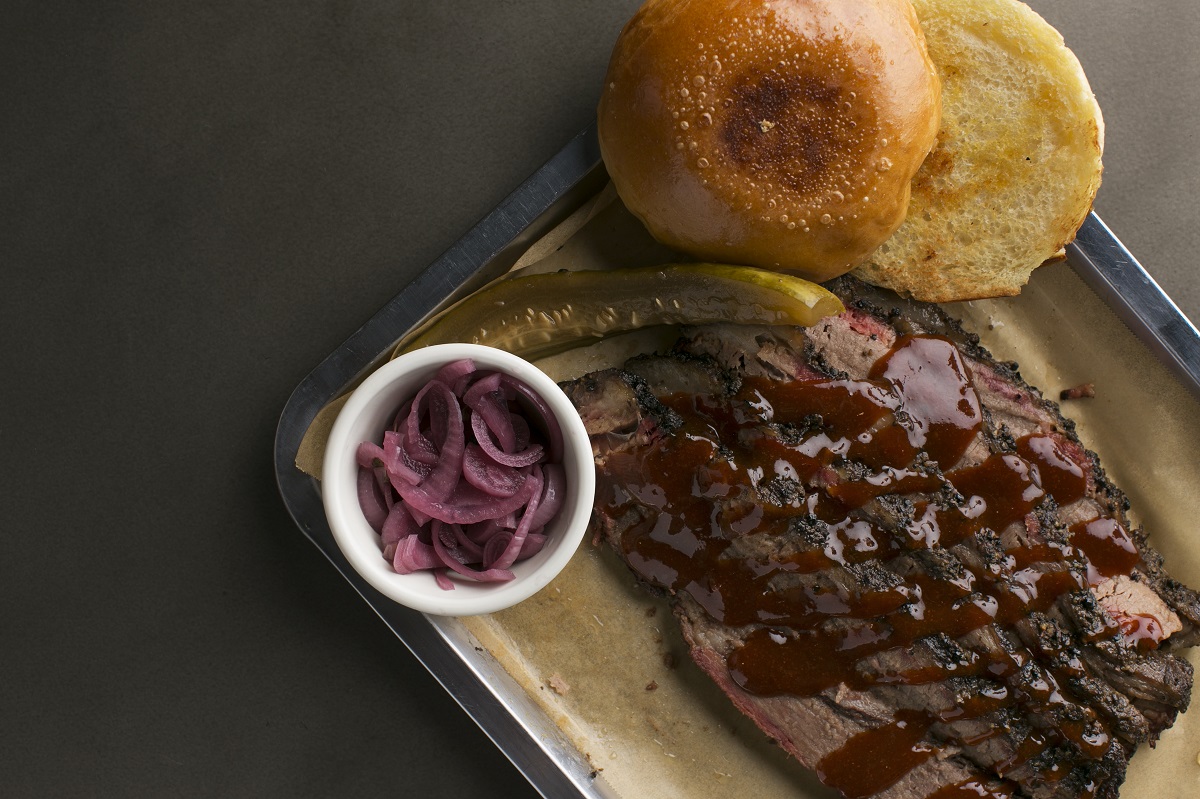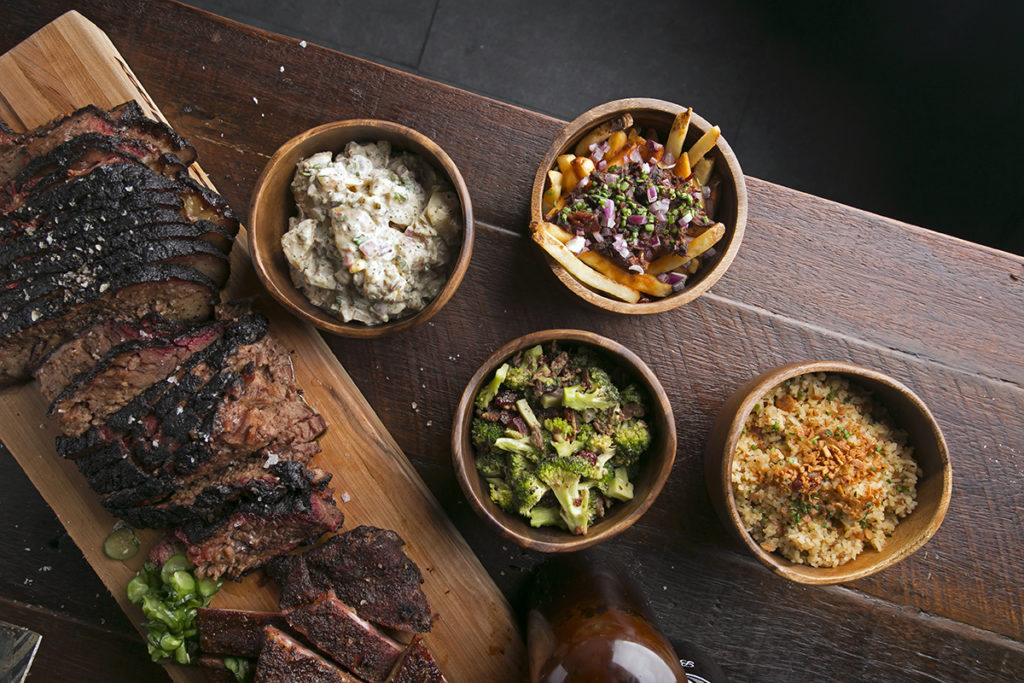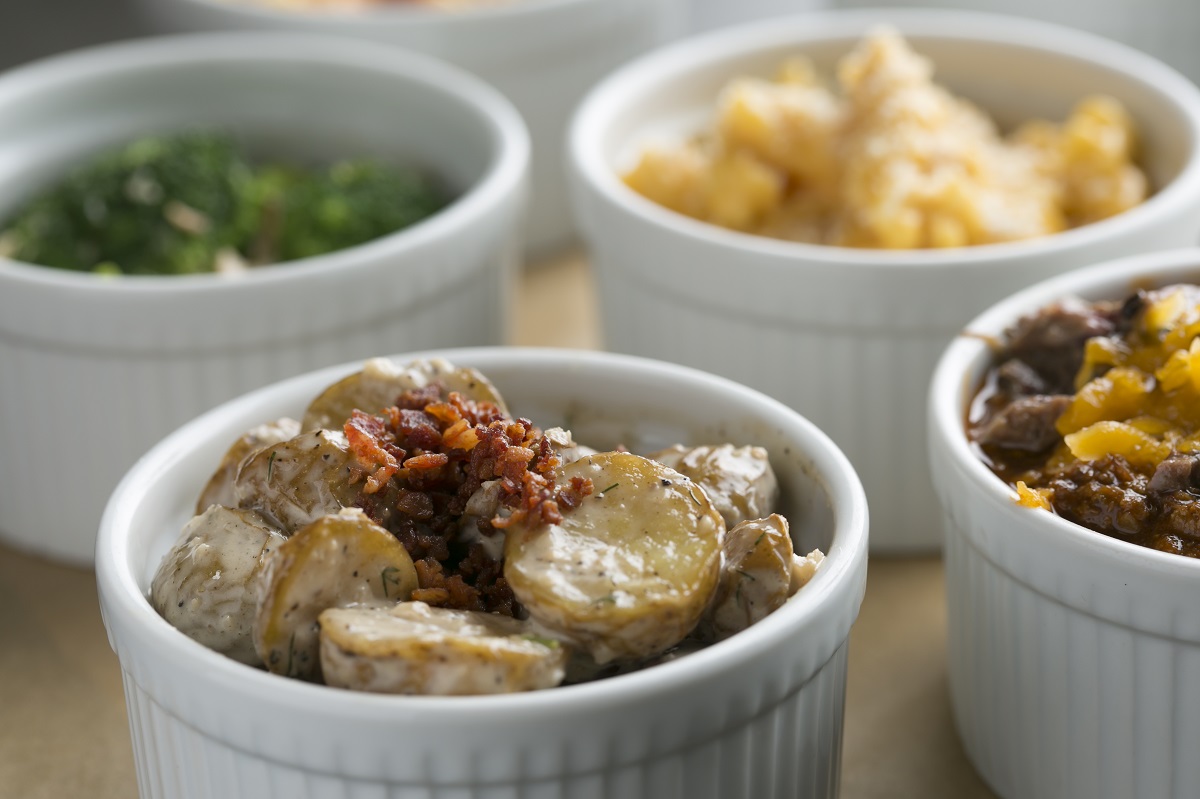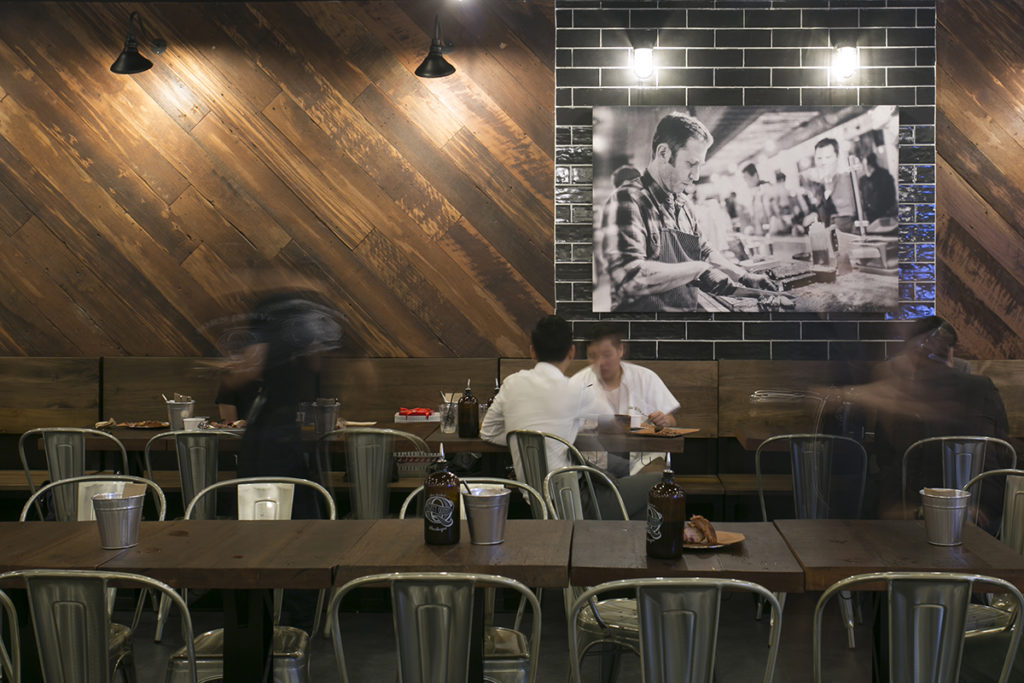Hugh Mangum began slicing through a huge slab of brisket—its blackened crust falling away from the blade to reveal intensely pink flesh beneath and release the aroma of cooked meat. The scent got the people watching to become even more alert, like predators sniffing the weakness of prey.
When the knife’s edge finally touched the slicing board, Mangum picked up a halved chunk of flesh and presented its sliced side to his audience proudly. There it was: a quarter-inch smoke ring so rosy, full of promise of flavor and heat, the sign of a well-smoked barbecue. At its sight, people broke into applause.
It was the lunchtime opening of Mighty Quinn’s in Manila, the New York barbecue joint that Mangum had built (and earned a two-and-a-half-star review from The New York Times) and the restaurant whose marketing had gotten self-proclaimed foodies in the metro talking excitedly about barbecue—and not the grilled, skewered, and sauce-doused kind that’s often treated as a secondary or tertiary dish at a Filipino fiesta table.
It’s barbecue with gravitas, the kind that demands to be the main show, what with the laborious cooking process it requires and the immense satisfaction it delivers.
“Barbecue,” in the purist American culinary sense, isn’t so much a verb as it is a noun. “You do not barbecue meat; you smoke it until it becomes barbecue,” stated The Economist in its December 2010 story “Fire in the Hole.”
“The thing with the term ‘barbecue’ is, there’s no right or wrong way of using it,” says Hugh Mangum. “Through time, it became a verb for people to signify how they cook meat: ‘to barbecue.’ But based on its origins, barbecue is what’s made when meat is cooked over indirect heat for a long period—anywhere from 12 to 24 hours—with live wood as fuel.”
Mangum, who is also Mighty Quinn’s pitmaster and therefore an expert on the topic, is willing to let pass certain connotations though. “The thing with the term ‘barbecue’ is, there’s no right or wrong way of using it,” he says as he surveyed the scene of people chowing down on dark chunks of meat.
“Through time, it became a verb for people to signify how they cook meat: ‘to barbecue.’ But based on its origins, barbecue is what’s made when meat is cooked over indirect heat for a long period—anywhere from 12 to 24 hours—with live wood as fuel.”
Within a commercialized setting such as Mighty Quinn’s, it becomes easy to forget that this American classic had very humble beginnings. “It started from the meat that was cast away by ranch hands to the migrant workers,” Mangum narrates. “The peasants then learned how to take the brisket, which is very hard to cook, and make it palatable.”
“It’s uniquely American in the sense that its inception actually happened in America, one of the few things we can say we created, as opposed to taking something from somewhere else and making it ours.”
Widely agreed to have adopted its name from the Spanish word barbacoa, barbecue was a well-established dish in the American South by the 19th century, with different regions such as Texas, North Carolina, Memphis, and Kansas developing their own cooking style and flavor profile.
“It’s uniquely American in the sense that its inception actually happened in America, one of the few things we can say we created, as opposed to taking something from somewhere else and making it ours.” Unlike the fast yet nutritionally dubious appeal of hamburgers and hotdogs, barbecue resonates with the soul and culture it was born from. But will it have an equally strong hold on Filipinos?
Warm welcome
Juano Gutierrez of Holy Smokes BBQ hopes so, but he is keeping his expectations realistic. On soft opening since October, his cozy smokehouse has fast become a favorite pit stop for families willing to endure the Makati traffic and brave the parking difficulty in Poblacion’s narrow residential streets for a taste of its buttery soft brisket and meaty ribs. Gutierrez’s experience in finding the right formula for smoking meats keeps him cautiously optimistic.

He and chef Red Espiritu began experimenting on smoking in late 2014, drawn by the appeal of American barbecue that they’d see all over food channels and food blogs. “There weren’t any American-style barbecue houses in Manila then, and we became passionate about bringing that authenticity here.”
Aside from determining the right temperature and length of time to cook each kind of meat, finding the right kind of wood is crucial, as it influences the meat’s flavor. “Pecan, we found out, creates a nutty flavor, while oak wood is very subtle,” Gutierrez says. They eventually decided on santol, which creates the closest flavor profile to that of applewood but is easier to source locally.
Aside from determining the right temperature and length of time to cook each kind of meat, finding the right kind of wood is crucial, as it influences the meat’s flavor.
“It brings a sweet note to the meat, and we know Filipinos like a sweet flavor profile.” For eight months, the two would start smoking at midnight for up to 14 hours, and plenty of “imperfectly” smoked meats were discarded along the way.
It was neither an easy nor inexpensive process: Aside from the costly raw materials, they also had to have an offset smoker custom-made so it would fit in the narrow space beside the two-story house that is now Holy Smokes BBQ and would send smoke in a direction that would least inconvenience the neighbors.
“Sometimes I’d ask myself why we’re doing this because it’s tiring,” Gutierrez admits; he and Espiritu still start smoking their meats at midnight, in time for the restaurant to open at 5 p.m. “But the food we make and seeing people enjoy it are worth it.”
Joint venture

Another player, the newest one, is Smoking Joint, and co-owner Jack Stehmeier is quick to say that it is not your typical barbecue restaurant that centers on being authentic. “It is a smokehouse that cooks meats the traditional way they do in the American South but with a twist that appeals to the Filipino palate. It features the trinity of BBQ: ribs, brisket, and pulled pork. Plus others that reinvent the wheel: fish, chicken, and duck breast.
The Smoking Joint, like the owners of Holy Smokes BBQ, agree that slow cooking requires time and effort. “But the tedious task is rewarding.” And it comes in the form of tender, smoky food. “Filipinos are very fond of grilling and barbecue. Put the two together and the result should appeal to the Filipino market.”
Could the current focus on slow-smoked meat be a continuation of the rising appreciation for slow food? “It could be subconsciously a part of the slow food movement, but I think it’s more of people looking for something authentic, especially in food,” Jamie Garaci answers.
Smoking Joint, Mighty Quinn’s, and Holy Smokes BBQ seem to be proof that slow-smoked barbecue will be the next food trend to crest this year. While there are other smokehouse joints that have been around for a few years already, the concentration of at least four new places opening last year (Pitmaster Smokehouse BBQ in Kapitolyo and Smokeyard, also in Poblacion) seem to indicate that Manila is ready to read more closely into the delicious smoke signals coming its way.
Jamie Garaci, managing partner of The Standard Group, which brought Mighty Quinn’s to the country, agrees. “Meat is one of the last few frontiers in food, one that can still be developed, at least locally.” She points out the Filipinos’ affinity for meat, especially the oft-discarded parts that get deliciously reincarnated as sisig or bopis, much like how the brisket used to be in the US.
“As a carnivorous market, we’re looking for the next big thing in meat.” Could the current focus on slow-smoked meat be a continuation of the rising appreciation for slow food? “It could be subconsciously a part of the slow food movement, but I think it’s more of people looking for something authentic, especially in food,” Garaci answers.
The real deal

“Authenticity” is a key concept that keeps popping up in discussions about American-style barbecue. In differentiating grilled barbecue from the slow-smoked kind, Mangum says it’s much easier to get away with certain liberties with the former.
“You can grill using gas, wood, charcoal, or even electricity. While you can’t necessarily hide imperfections in grilled barbecue, most dining establishments tend to make up for them by drowning the meat in sauce, which is okay. It would still be delicious. With smoking meat, if it isn’t done right, the ribs would easily fall off the bone or the meat would look gray. But if you get to know how to do it right, something magical happens with the meat, something that can’t be mimicked.”
Ribs that don’t fall off the bone may sound sacrilegious to a crowd that has been weaned on Racks, but Gutierrez elaborates on the particular pleasure that a chewier, firmer, perfectly smoked meat could bring. “First you taste the peppery crust, all the spices and herbs that were in the rub that now saturates the meat. Then you feel the bite to the barbecue, you relish how your teeth sink into it. But the meat isn’t tough at all: If it’s good barbecue, it’ll be a clean bite.”
Among the four regional styles that can be found in the US, it’s the Texan one that Mighty Quinn’s, Smoking Joint, and Holy Smokes BBQ are offering—or at least, in the former’s case, it’s in their DNA.
To help ease the local palate into the peppery, spicy flavor of Texas-style barbecue, Holy Smokes BBQ presents side dishes that have a citrusy profile: cilantro creamed corn, Cajun rice, garlic lemon broccoli. There’s also mac and cheese, whose richness can cushion and balance the piquancy of the meat. As for sauces, they offer three: smoky original; sweet and tangy; and spicy.
A smoking brotherhood

“Barbecue alone encompasses the high- and lowbrows, the sacred and the profane, the urban and the rural, the learned and the unlettered, the blacks, the browns, the yellows, the reds, and the whites,” Lolis Eric Elie wrote in “Smokestack Lightning,” a seminal book on barbecue, and his sentiment is shared by Mangum, Gutierrez, and Espiritu.
“Whenever I visit my father in Texas, we would go to these roadside barbecue places and see people who are dressed nicely, coming up in limos, and people coming in fresh from the oil rigs,” Mangum shares. “And where they come from doesn’t matter. When you’re eating barbecue, you’re family.”
“Filipinos are very family-oriented, and the barbecue culture is very similar to that,” Gutierrez opines on what could help make slow-smoked barbecue click in Manila. “We put everything in the middle of the table for everyone to share. Now, Filipinos love to have barbecue with rice, but I would love for them to experiment also with novel ways of enjoying barbecue.” Espiritu adds, “And we encourage people to eat with their hands, which adds to the pleasure of eating.
“Whenever I visit my father in Texas, we would go to these roadside barbecue places and see people who are dressed nicely, coming up in limos, and people coming in fresh from the oil rigs,” Mangum shares. “And where they come from doesn’t matter. When you’re eating barbecue, you’re family.”
Every trend brings out competitors from the woodwork, but with the difficulty in creating the perfect slow-smoked barbecue, there could be a community of smokers created instead: Gutierrez had eaten at Mighty Quinn’s, Mangum had tasted Holy Smokes BBQ’s meats, and Espiritu and Gutierrez personally know the folks behind other smokehouses around the city. “We plan to form a small group to meet once a month to share secrets and tips,” reveals Espiritu. “Smokeyard, Mighty Quinn’s, Pitmaster, Big D’s. It’s a tight-knit community, and we respect each other for doing this kind of food.”
“It’s nice that we’re getting into smoked barbecue the same time as others are,” Garaci says. “We see these independent smokehouses in the metro as being in the same boat we’re in, cultivating a local eating culture that appreciates slow-smoked meat.”
The heat, so far, remains only in the kitchen and in the succulent, tender barbecue. “We’re happy to be at the forefront of this new movement.”





